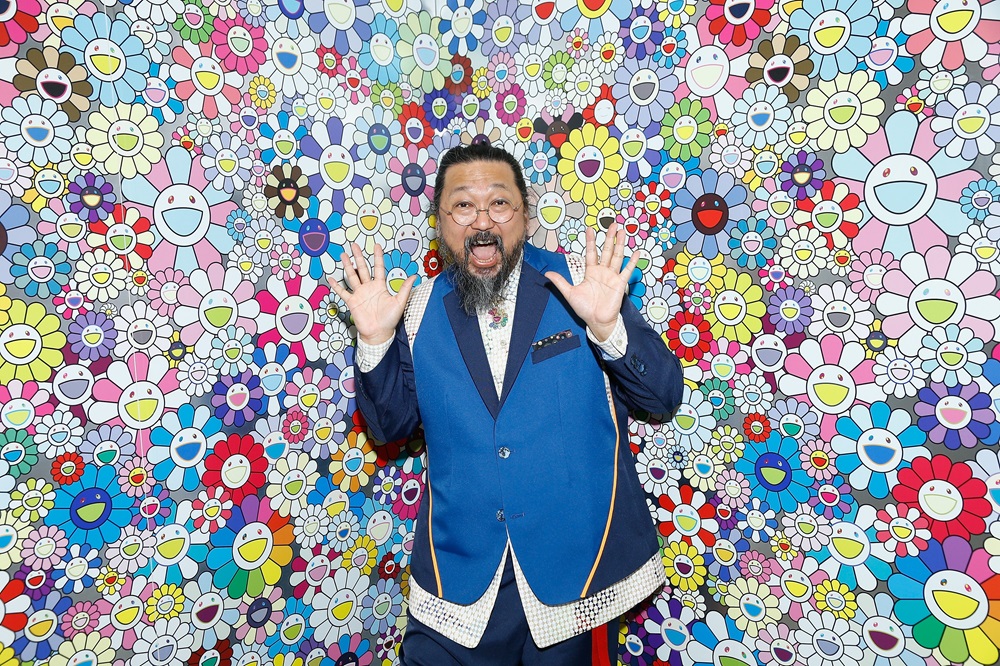Japanese art is a rich and varied heritage, including calligraphy, ceramics, painting, sculpture, and more. Its lengthy history spans thousands of years and has been shaped by numerous social, religious, and cultural elements. Historically, Japanese art is more into classical style and practice, and many styles and forms from different ideologies were conceived and treated well by the artist and the art practitioners.
Prehistoric and Ancient Periods, or Yayoi Period (300 BCE–300 CE), which witnessed the arrival of metalworking and early types of agriculture, and the Jomon Period (10,000–300 BCE), which is recognised for its unique pottery with cord-marked patterns. Buddhism was brought to Japan from China and Korea during the Asuka and Nara Periods (6th–8th centuries), significantly impacting Japanese sculpture, architecture, and art. The Heian Period (794–1185) is credited with developing Japanese courtly culture, including calligraphy, literature (especially The Tale of Genji), and the resurgence of classic Japanese painting techniques like Yamato-e.
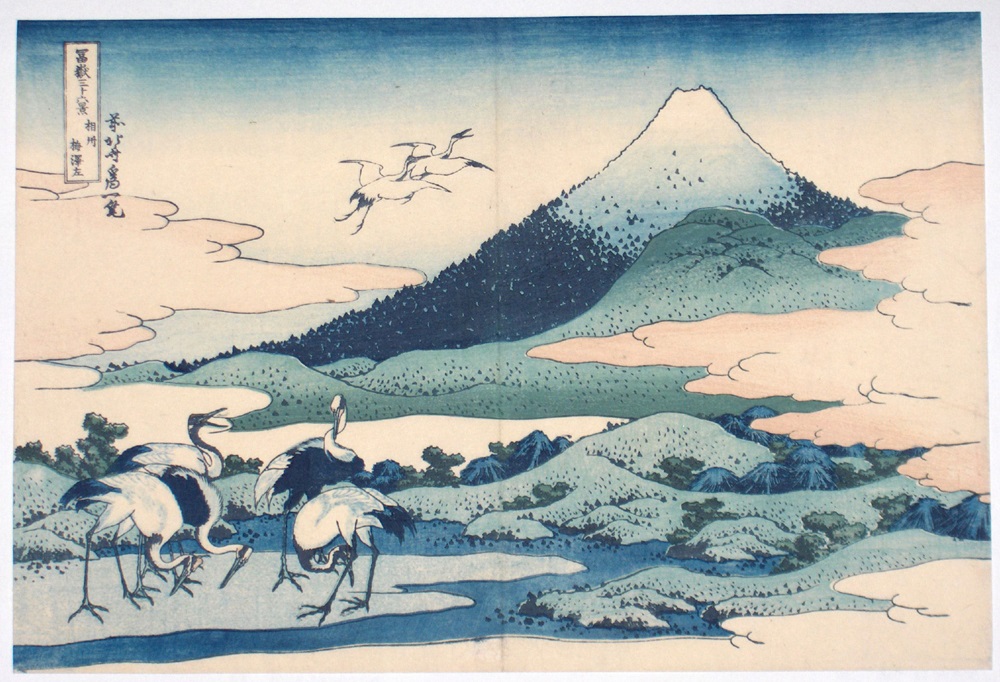
Zen Buddhism rose to prominence in the Kamakura and Muromachi Periods (1185–1573), influencing the aesthetics of tea ceremonies and other art forms like sumi-e or ink painting. The Azuchi-Momoyama Period (1573–1603) was characterized by political unrest and warfare. Still, it was also a time of significant cultural advancement, including the emergence of new painting movements like the Kano school and the development of tea ceremony culture. Under the Tokugawa shogunate, there was a period of comparatively calm and stable conditions during the Edo Period (1603–1868). Ukiyo-e woodblock prints, kabuki theatre, and ornamental arts like porcelain and lacquerware are examples of Edo-era art. Traditional Japanese art forms were combined with Western techniques and styles during Japan’s fast modernization and Westernization during the Meiji Restoration and Modern Period.
Significance of Japanese Art
Japanese art frequently displays a profound respect for the natural world, emphasising themes like landscapes, plants, animals, seasons, and natural events. The change of the seasons is a common source of inspiration for artists, who use it to convey their subjects’ beauty and fleeting nature. Japanese art emphasises restraint, refinement, and simplicity. This may be seen in many artistic mediums, including calligraphy, architecture, and painting, where practitioners aim to elicit meaning through spare, nuanced compositions and deft details.
In Japanese art, finding balance and harmony is fundamental. Attaining balance and fostering a sense of calm is prioritised in many creative endeavours, such as painting compositions, garden designs, and tea ceremony designs. Well-defined forms and smooth, flowing lines are frequently highlighted in Japanese art. The graceful lines of Japanese architecture and pottery, calligraphy (Shodo), and traditional ink painting (sumi-e) all demonstrate this.
Japanese artists are renowned for paying close attention to every little detail. Every detail is meticulously planned and carried out, whether in the delicate brushstrokes of a painting, the complex patterns of a kimono material, or the exact craftsmanship of a tea bowl. Buddhism—especially Zen Buddhism—has significantly impacted Japanese art. Zen philosophy, which strongly emphasises awareness, simplicity, and the enjoyment of the present moment, is evident in many facets of Japanese art, such as the aesthetics of tea ceremonies, rock gardens, and ink paintings.
Famous Japanese Artists
Renowned modern Japanese artist Takashi Murakami is well-known for his vibrant and wacky pieces that fuse pop culture themes with traditional Japanese art. After studying traditional Japanese painting, Murakami, born in Tokyo in 1962, completed a Ph.D. programme in Nihonga, a conventional materials and techniques-based form of Japanese painting. Murakami’s style changed to incorporate aspects of popular culture, manga, and anime, resulting in a distinctive look he called “Superflat.” This aesthetic is defined by two-dimensional, flat imagery that alludes to modern commercial society and traditional Japanese art forms like ukiyo-e prints.
Renowned Japanese artist Katsushika Hokusai (1760–1849) is primarily recognised for his “Thirty-Six Views of Mount Fuji” woodblock print series, which includes his most well-known piece, “The Great Wave off Kanagawa.” During the Japanese Edo period, Hokusai was born in Edo (now Tokyo), and he created a vast body of work in various media, such as woodblock prints, paintings, and drawings. Hokusai’s art reflects his great respect for the natural world, especially Mount Fuji, which he portrayed in many settings over his career. His artwork frequently conveys the majesty and force of everyday Japanese life and natural events from the Edo period.
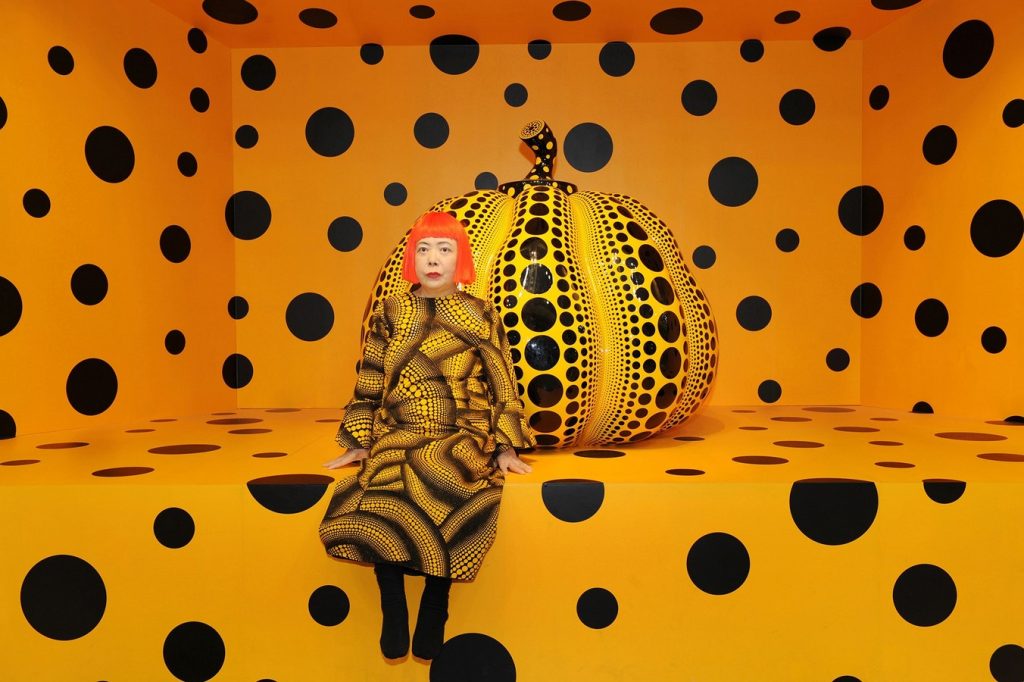
Japanese contemporary artist Yayoi Kusama is well-known for her avant-garde paintings, sculptures, installations, and performance art. Kusama, born in Matsumoto, is renowned for her visual language, defined by vivid colours, repeating patterns, and obsession with polka dots and infinite nets. After relocating to New York City in the 1950s, Kusama became involved with the avant-garde trends of the day, such as Pop Art and Minimalism, which launched her artistic career. She became well-known during this time for her immersive installations, sometimes called “Infinity Mirror Rooms,” which use mirrors, lights, and repeating shapes to give the impression of infinite space.
Modern Japanese artist Chiharu Shiota is well-known for her immersive installations, frequently using commonplace items like beds, shoes, threads, and keys. Shiota, a Japanese artist born in Osaka in 1972, is well-known worldwide for her visually arresting and provocative pieces that tackle memory, identity, and the passing of time. Red or black thread is one of Shiota’s hallmark materials. She uses it to weave complicated constructions that resemble webs and encircle entire rooms or objects. These threads frequently represent the intricate web of relationships that mould our lives and the interdependence of human experiences and emotions.
Japanese contemporary artist Tetsuya Ishida is renowned for his eerie and surreal paintings that tackle alienation, identity, and the stresses of daily life. Ishida was born in Yaizu, Shizuoka Prefecture, Japan, in 1973. His work became well-known for its unique aesthetic and thought-provoking subjects. In Ishida’s paintings, anonymous people are frequently entangled in ordinary or fantastical situations with urban or industrial backdrops. His figures’ features are usually expressionless or blank, giving the impression that they are detached from their environment.
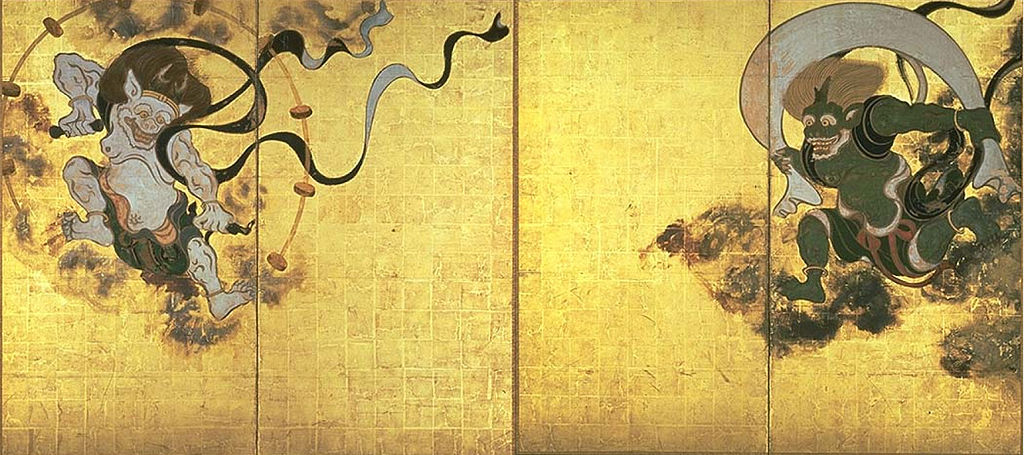
Renowned Japanese artist Taro Okamoto was well-known for his contributions to the country’s avant-garde art movement and his audacious and energetic style. Okamoto was born in Kawasaki, Japan, in 1911. Over several decades, he worked in various media, including painting, sculpture, and public art. Okamoto’s compositions are known for their vibrancy and energy, and they frequently include surreal or abstract imagery that draws inspiration from modernist aesthetics, mythology, and Japanese folk art. Traditional Japanese art styles, including ukiyo-e prints and Noh theatre, and Western art movements like surrealism and cubism influenced him.
Early in the 17th century, Tawaraya Sotatsu, a Japanese artist, made essential contributions to Japanese art, especially in painting and design. He worked in the early Edo and Azuchi-Momoyama periods, spanned the late 16th and early 17th centuries. With Hon’ami Kōetsu, a well-known calligrapher and craftsman, Sotatsu co-founded the Rinpa School of Painting. The term “school of Korin,” or Rinpa, comes from Ogata Korin, another significant artist who developed the ideas and methods of Sotatsu.
Contemporary Japanese artist Hiroshi Senju is renowned for his stunning paintings of waterfalls that blend traditional Japanese methods with a modern aesthetic. Senju, born in Tokyo in 1958, is famous for his distinct style of depicting the majesty and force of nature in his works of art. Senju’s hallmark technique is painting waterfalls on mulberry paper with mineral pigments. This process is developed from traditional Japanese painting techniques called Nihonga. With great attention to detail and a sharp perspective, he frequently depicts spectacular natural settings with rushing waterfalls in his compositions.
During the Muromachi period (1336–1573), a well-known Japanese ink painter named Sesshū Tōyō was a famous artist. Sesshū, born in 1420 in what is now Okayama Prefecture, Japan, is regarded as one of the most influential figures in Japanese art history, especially in ink painting (sumi-e). Sesshū is well known for his inventive and skilful ink painting technique, which blends Japanese sensibilities and aesthetics with elements of Chinese literati painting. Before going to China in 1468 to improve his artistic study and expand his knowledge of Chinese painting techniques and philosophy, he studied under several masters in Japan.
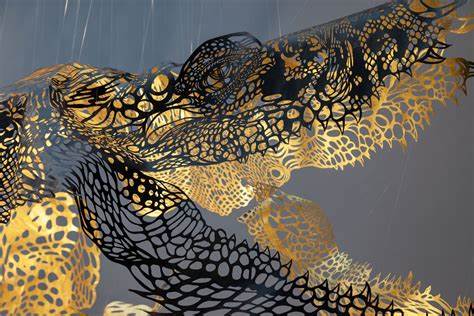
Japanese modern artist Chiho Aoshima is renowned for her vivid and surreal digital works of art that combine pop culture imagery with traditional Japanese art components. Aoshima, born in Tokyo in 1974, became well-known in the early 2000s as a critical figure in the Superflat movement, which Takashi Murakami, an artist, led. Aoshima uses computer software to make her artwork, which combines aspects of manga, anime, and Japanese mythology with detailed digital drawings. Imaginary landscapes inhabited by funny animals, ghosts, and otherworldly beings are a common characteristic of her paintings.
Renowned Japanese painter Hasegawa Tōhaku (1539–1610) was active during the Azuchi–Momoyama period (late 16th century) and was well-known for his extraordinary ability to create traditional Japanese paintings, especially in the Yamato-e and Suibokuga (ink painting) styles (Japanese-style painting). The most notable work of Tōhaku’s art is “Pine Trees” (Shōrin-zu byōbu), a six-panel folding screen with gnarled pine trees on a background of gold leaf. This famous piece is praised for its exacting attention to detail, dynamic composition, and deft use of negative space by the artist to evoke a feeling of depth and movement.
Renowned Japanese artist Kawase Hasui (1883–1957) was well-known for his beautiful woodblock prints (ukiyo-e) depicting landscapes, especially Japanese landmarks and landscapes. The Shin-Hanga (“New Prints”) movement, which aimed to revive traditional Japanese woodblock printmaking methods in the early 20th century, benefited from Hasui’s artwork. Hasui, raised in Tokyo, studied painting first and then printmaking under the famous woodblock print artist Kaburagi Kiyokata. European Impressionism influenced Hasui’s early works, but he later created his unique style, distinguished by meticulous attention to detail and command of composition and colour.
Japanese artist Kazuo Shiraga (1924–2008) was a member of the avant-garde Gutai group, which originated in post–World War II Japan. Shiraga was renowned for his avant-garde method of painting, especially the way he used his body to express himself artistically. Shiraga studied traditional Japanese painting before joining the Gutai group in the 1950s and was born in Amagasaki, Japan.
Modern Japanese artist Makoto Aida is renowned for his thought-provoking and socially conscious works that tackle complex subjects, including politics, consumerism, nationalism, and cultural identity. Born in Niigata, Japan, in 1965, Aida became well-known in the 1990s for his audacious and forceful painting style. Various media, including painting, sculpture, installation, performance, and video, are used in Aida’s work. His large-scale paintings that fuse traditional Japanese techniques with modern subject matter and imagery made him most famous.
Modern Japanese artist Mariko Mori is well-known for her multimedia installations, sculptures, and pictures that tackle subjects like technology, spirituality, and what it means to be human in the present world. Born in Tokyo in 1967, Mori gained notoriety in the 1990s and gained recognition across the globe for her avant-garde and provocative artwork. “Wave UFO” (1999), a massive installation with a futuristic, spaceship-like structure hovering in midair, is one of Mori’s most well-known pieces. Entering the exhibit will immerse visitors in a music, light, and interactive atmosphere that evokes awe and an ethereal sensation of extraterrestrial beings.
Japanese artist Nahoko Kojima is renowned for her exquisite and delicate paper-cut sculptures, each made from a single sheet of paper. Kojima, a native of Hyogo Prefecture in Japan, blends traditional Japanese paper-cutting methods with contemporary aesthetic sensibilities. Incredibly accurate and detailed depictions of animals, plants, and other natural things are expected in Kojima’s sculptures. She painstakingly removes layers of paper to produce complex textures and patterns, creating three-dimensional works of art that seem almost weightless and ethereal.
The Japanese-French painter and printmaker Tsuguharu Foujita, also known as Leonard Tsuguharu Foujita, was renowned for his unique fusion of Eastern and Western artistic inspirations. After relocating to Paris in 1913, Foujita—born in Tokyo in 1886—became involved with the avant-garde art movement of the early 20th century and the School of Paris. Early works by Foujita were influenced by Western art styles, including Fauvism and Cubism, as well as traditional Japanese art, particularly ukiyo-e woodblock prints. His paintings of cats, nudists, and scenes from Parisian life are his most well-known works; they are distinguished by their exquisite lines, delicate colours, and meticulous attention to detail.
Japanese woodblock print artist Utagawa Hiroshige (1797–1858) was one of the most well-known of the Edo period. His landscape print series, “The Fifty-three Stations of the Tōkaidō” (Tōkaidō Gojūsan-tsugi), which features scenes along the Tōkaidō road—the primary route connecting Edo (modern-day Tokyo) and Kyoto—is his most well-known work. Born in Edo (modern-day Tokyo), Hiroshige first studied to become a fire warden before becoming an artist. After starting his studio under the Utagawa school, where he was given the artistic moniker Hiroshige, he trained under the ukiyo-e master Utagawa Toyohiro.
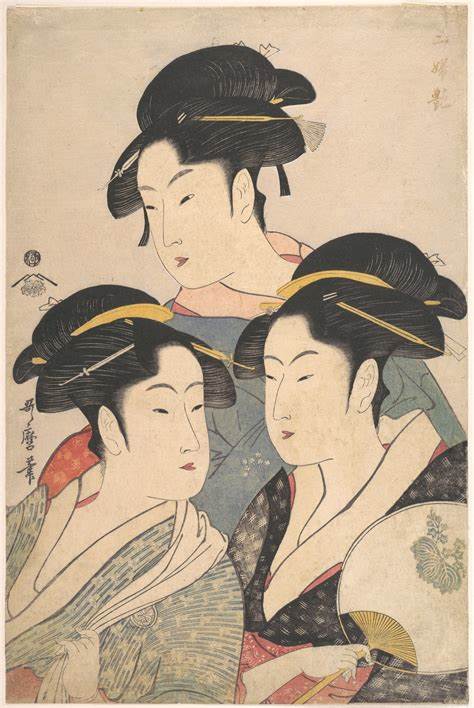
Japanese ukiyo-e artist Utamaro Kitagawa, often known as just Utamaro, was active during the Edo period (17th to 19th centuries). He is well known for his magnificent woodblock prints that portray scenes of daily life in Edo’s ukiyo, or “floating world,” as well as attractive women (bijin-ga) (modern-day Tokyo); delicate lines, subdued colours, and meticulous attention to detail that define Utamaro’s work. He was a master at expressing the grace and elegance of ladies, frequently presenting them in private and domestic contexts when they were getting ready for an event, practising an instrument, or engaging in leisure activities.
Born Sakai Hidemaro (1868–1958), Yokoyama Taikan was a well-known Japanese painter of the late 19th and early 20th century who made essential contributions to the Nihonga (Japanese-style painting) movement. He was instrumental in bringing back traditional Japanese painting methods while fusing contemporary themes and aspects into his paintings. Born in Japan’s Niigata Prefecture, Taikan trained under several artists before developing his style. The natural beauty of Japan, particularly its mountainous regions, profoundly affected him and frequently appeared in his works.
Kishio Suga, 1944–2019, was a well-known Japanese artist connected to Japan’s late 1960s–early 1970s Mono-ha (School of Things) movement. Mono-ha was distinguished by its investigation of the connections between industrial and natural materials and the interplay between matter and space. Suga attended Tama Art University in Tokyo to study painting after being born in Morioka, Iwate Prefecture, Japan. However, he quickly lost interest in standard artistic methods and started experimenting with unusual supplies and techniques.

